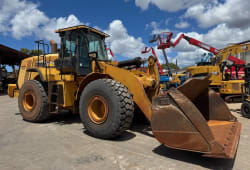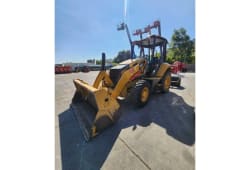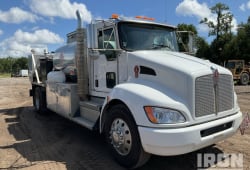Tips to Get Paid Faster When Selling Your Heavy Equipment
11 Min read
)
October 19, 2023
Selling heavy equipment can be a lucrative business, but it can also come with its fair share of challenges. One of the most common challenges that sellers face is getting paid promptly for their equipment. In this article, we will explore some key strategies that you can implement to ensure you get paid faster when selling your heavy equipment. However, if you want the fastest way to get paid without any of the headaches of selling then you should list your equipment with Boom & Bucket.
Understanding the Heavy Equipment Market
Before delving into the strategies, it's important to have a good understanding of the heavy equipment market. This knowledge will help you navigate through the complexities of the market and make informed decisions when selling your equipment.
The heavy equipment market is a vast and dynamic industry that encompasses a wide range of machinery used in construction, mining, agriculture, and other sectors. From excavators and bulldozers to cranes and loaders, heavy equipment plays a crucial role in various operations.
One key factor influencing the heavy equipment market is economic conditions. When the economy is thriving, construction and infrastructure projects are on the rise, leading to an increased demand for heavy equipment. On the other hand, during economic downturns, the demand for equipment may decrease as construction activities slow down.
Another factor that significantly impacts the heavy equipment market is industry demand. Different industries have varying needs for heavy machinery. For example, the construction industry requires a wide range of equipment to carry out tasks such as earthmoving, material handling, and concrete pouring. The mining industry, on the other hand, relies heavily on specialized machinery for excavation and transportation of minerals.
Technological advancements also play a crucial role in shaping the heavy equipment market. As new technologies emerge, equipment manufacturers constantly strive to incorporate them into their products to enhance efficiency, productivity, and safety. For instance, the development of GPS and telematics systems has revolutionized the way heavy equipment is operated and monitored, enabling better fleet management and preventive maintenance.
Key Factors Influencing the Heavy Equipment Market
Several factors influence the heavy equipment market, and having an awareness of these factors can help you position your equipment for a faster sale. Factors such as economic conditions, industry demand, and technological advancements play a significant role in determining the demand and pricing of heavy equipment.
Economic conditions, including factors like GDP growth, interest rates, and government spending on infrastructure projects, have a direct impact on the heavy equipment market. By keeping track of economic indicators, you can anticipate market trends and adjust your selling strategies accordingly.
Industry demand is another crucial factor to consider. Monitoring the growth and development of industries that heavily rely on heavy equipment, such as construction, mining, and agriculture, can give you valuable insights into the demand for specific types of machinery.
Technological advancements in heavy equipment have transformed the industry in recent years. From advanced fuel-efficient engines to automated control systems, these innovations have improved the performance, safety, and environmental sustainability of heavy machinery. Understanding the latest technological trends can help you highlight the unique features and benefits of your equipment, making it more attractive to potential buyers.
The Role of Supply and Demand in Pricing
Supply and demand dynamics have a direct impact on the pricing of heavy equipment. Understanding these dynamics is crucial for setting the right price for your equipment and attracting potential buyers. When demand is high and supply is limited, you have a better chance of selling your equipment faster and at a higher price.
Supply in the heavy equipment market is influenced by various factors, including equipment manufacturing capacity, rental fleets, and used equipment availability. If the supply of a particular type of equipment is scarce, sellers can command higher prices due to increased competition among buyers.
On the other hand, demand for heavy equipment is driven by factors such as infrastructure development, construction projects, and industry growth. By staying informed about upcoming projects and industry trends, you can identify potential buyers who are actively seeking the equipment you have for sale.
Pricing your equipment appropriately requires a careful analysis of supply and demand dynamics. Factors such as equipment condition, age, usage history, and market demand for similar equipment should be considered when determining the right price. By striking the right balance between supply and demand, you can maximize your chances of a successful sale.
Preparing Your Heavy Equipment for Sale
Properly preparing your heavy equipment for sale is essential to attract serious buyers and expedite the selling process. However, there are several additional steps you can take to ensure that your equipment stands out from the competition and captures the attention of potential buyers.
Importance of Maintenance and Repairs
Regular maintenance and repairs can significantly increase the value of your equipment and make it more appealing to potential buyers. It is crucial to conduct a thorough inspection of your equipment to identify any mechanical issues that need to be addressed. By fixing these issues before listing your equipment for sale, you can provide buyers with the assurance that they are investing in a reliable and well-maintained piece of machinery.
In addition to addressing mechanical issues, it is also important to keep thorough records of all maintenance and repairs. These records can serve as a valuable selling point, as they demonstrate the level of care and attention that has been given to the equipment throughout its lifespan. Providing potential buyers with a comprehensive maintenance history can instill confidence and help justify the asking price.
Presenting Your Equipment in the Best Light
When advertising your equipment, it's crucial to present it in the best light possible. While high-quality, detailed photographs are a must, there are several other factors to consider to make your equipment stand out.
Firstly, make sure to take photographs from various angles, highlighting the key features of the equipment. This will give potential buyers a clear and comprehensive view of what they can expect. Additionally, consider capturing images of the equipment in action, showcasing its functionality and performance.
Accurate and comprehensive descriptions are also vital when presenting your equipment for sale. In addition to providing specifications such as make, model, and year, include details about the equipment's usage history. This can include information about the types of projects it has been used for, the number of hours it has been operated, and any notable achievements or milestones it has reached.
Furthermore, don't forget to mention any additional accessories or attachments that are included in the sale. This can add value to the equipment and make it more appealing to potential buyers who may be looking for a complete package.
By taking the time to properly prepare your heavy equipment for sale and presenting it in the best light, you can increase your chances of attracting serious buyers and achieving a successful sale. Remember, attention to detail and thoroughness can make all the difference in the competitive market of heavy equipment sales.
Setting the Right Price for Your Equipment
Pricing your heavy equipment appropriately is crucial for attracting potential buyers and getting paid faster.
When it comes to setting the right price for your equipment, there are several factors to consider. One of the most important considerations is evaluating your equipment's worth. Before you can determine a fair price, you need to take into account various factors such as age, usage, condition, market demand, and comparable sales. By carefully evaluating these factors, you can get a better understanding of the true value of your equipment.
Researching the market is another essential step in the pricing process. By studying the market, you can gain valuable insights into the average prices for similar equipment in your area. This information will help you gauge the competitiveness of your pricing and ensure that you are not overpricing or underpricing your equipment.
Evaluating Your Equipment's Worth
Before setting a price for your equipment, it's essential to evaluate its worth. Consider factors such as age, usage, condition, market demand, and comparable sales. Research the market to get a sense of the average prices for similar equipment in your area.
Age is an important factor to consider when evaluating the worth of your equipment. Older equipment may have a lower market value due to wear and tear, technological advancements, and changes in industry standards. On the other hand, newer equipment may have a higher value, especially if it comes with advanced features or improvements that make it more efficient and productive.
Usage is another crucial factor that can impact the worth of your equipment. Heavy equipment that has been used extensively may have higher maintenance costs and a shorter remaining lifespan, which can affect its market value. Conversely, equipment that has been lightly used or well-maintained may command a higher price.
The condition of your equipment is also a significant consideration. Equipment that is in excellent working condition, with minimal wear and tear, will generally have a higher value. Regular maintenance, repairs, and inspections can help ensure that your equipment remains in top shape and retains its value.
Market demand plays a vital role in determining the worth of your equipment. If there is high demand for a particular type of equipment in your area, you may be able to set a higher price. Conversely, if the market is saturated with similar equipment, you may need to adjust your pricing strategy to attract buyers.
Comparable sales refer to the prices at which similar equipment has been sold in the past. By researching and analyzing these sales, you can get a better idea of the fair market value for your equipment. This information can serve as a benchmark for setting your price and ensure that you are not overpricing or underpricing your equipment.
Pricing Strategies for Faster Sales
Using effective pricing strategies can help you sell your equipment faster. Consider pricing your equipment slightly below the market average to attract more interested buyers. This strategy can create a sense of urgency among potential buyers, as they may perceive your equipment as a great deal compared to others on the market.
Alternatively, you can set a firm price but offer flexible payment options to entice potential buyers. Installment plans or leasing arrangements can make your equipment more affordable and accessible to a wider range of buyers. This flexibility can be particularly appealing to small businesses or individuals who may not have the upfront capital to purchase the equipment outright.
Another pricing strategy to consider is bundling. If you have multiple pieces of equipment that complement each other or are commonly used together, you can offer them as a package deal. This approach can attract buyers who are looking for a complete set of equipment and may be willing to pay a premium for the convenience and cost savings.
Lastly, it's important to regularly review and adjust your pricing strategy based on market conditions and buyer feedback. By staying informed about industry trends and customer preferences, you can ensure that your pricing remains competitive and attractive to potential buyers.
Choosing the Right Sales Channel
Deciding on the most appropriate sales channel for your heavy equipment can significantly impact the speed at which you get paid.
Pros and Cons of Different Sales Channels
There are various sales channels available, both online and offline. Each channel has its own advantages and disadvantages, so it's essential to weigh the pros and cons before making a decision. Online platforms offer a wide reach and convenience, while offline channels such as auctions or direct sales give you more control over the selling process.
Online vs. Offline Sales: What's Best for You?
Consider your target audience, the type of equipment you are selling, and your personal preferences when deciding between online and offline sales channels. Sometimes, a combination of both approaches can yield the best results.
Negotiating with Buyers
Negotiation is an integral part of the selling process. Following some key tips can help you secure a fair deal and ultimately get paid faster.
Tips for Successful Negotiation
Approach negotiations with a clear understanding of your equipment's value and your desired selling price. Be open to reasonable offers, but also know your bottom line. Good communication, responsiveness, and flexibility can go a long way in reaching a mutually beneficial agreement with potential buyers.
Avoiding Common Negotiation Pitfalls
Negotiations can sometimes be challenging, but being aware of common pitfalls can help you navigate them successfully. Avoid rushing into hasty decisions, getting emotionally attached to your equipment, or giving in to unrealistic demands. Stick to your selling plan and negotiate with confidence.
By understanding the heavy equipment market, preparing your equipment properly, setting the right price, choosing the optimal sales channel, and skillfully negotiating with buyers, you can increase your chances of getting paid faster when selling your heavy equipment. Implement these strategies, and watch your sales process become more efficient and rewarding.

Caleb Woods is an experienced content specialist and an editor at Boom & Bucket, blending his journalism background with expertise in the heavy equipment industry. He delivers engaging, informative content to help professionals stay informed and make smarter decisions in the machinery market.














